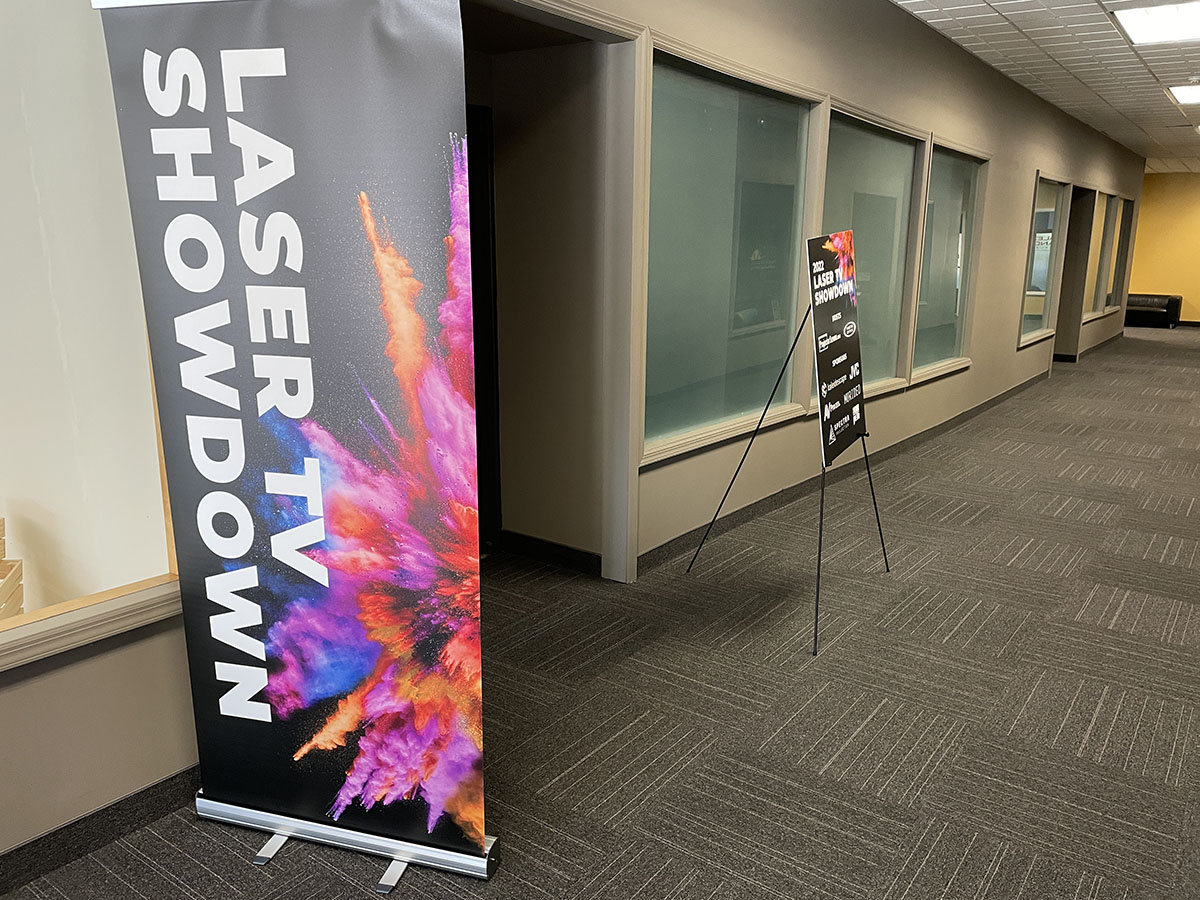 So, this is cool… I was recently invited to judge the first-ever Laser TV Showdown at the ProjectorScreen.com facility in New Jersey. Hosted by Rob Sabin of ProjectorCentral.com, eight single-laser and six triple-laser ultra-short throw (UST) projectors were pitted in a grueling side-by-side comparison to decide which is best. I and five other video reviewer/calibrators judged the projectors on contrast, color accuracy, and other parameters. A winner was chosen in the single-laser and triple-laser categories using scores collected from the six judges and weighted in favor of those things that most affected picture quality and the user experience.
So, this is cool… I was recently invited to judge the first-ever Laser TV Showdown at the ProjectorScreen.com facility in New Jersey. Hosted by Rob Sabin of ProjectorCentral.com, eight single-laser and six triple-laser ultra-short throw (UST) projectors were pitted in a grueling side-by-side comparison to decide which is best. I and five other video reviewer/calibrators judged the projectors on contrast, color accuracy, and other parameters. A winner was chosen in the single-laser and triple-laser categories using scores collected from the six judges and weighted in favor of those things that most affected picture quality and the user experience.
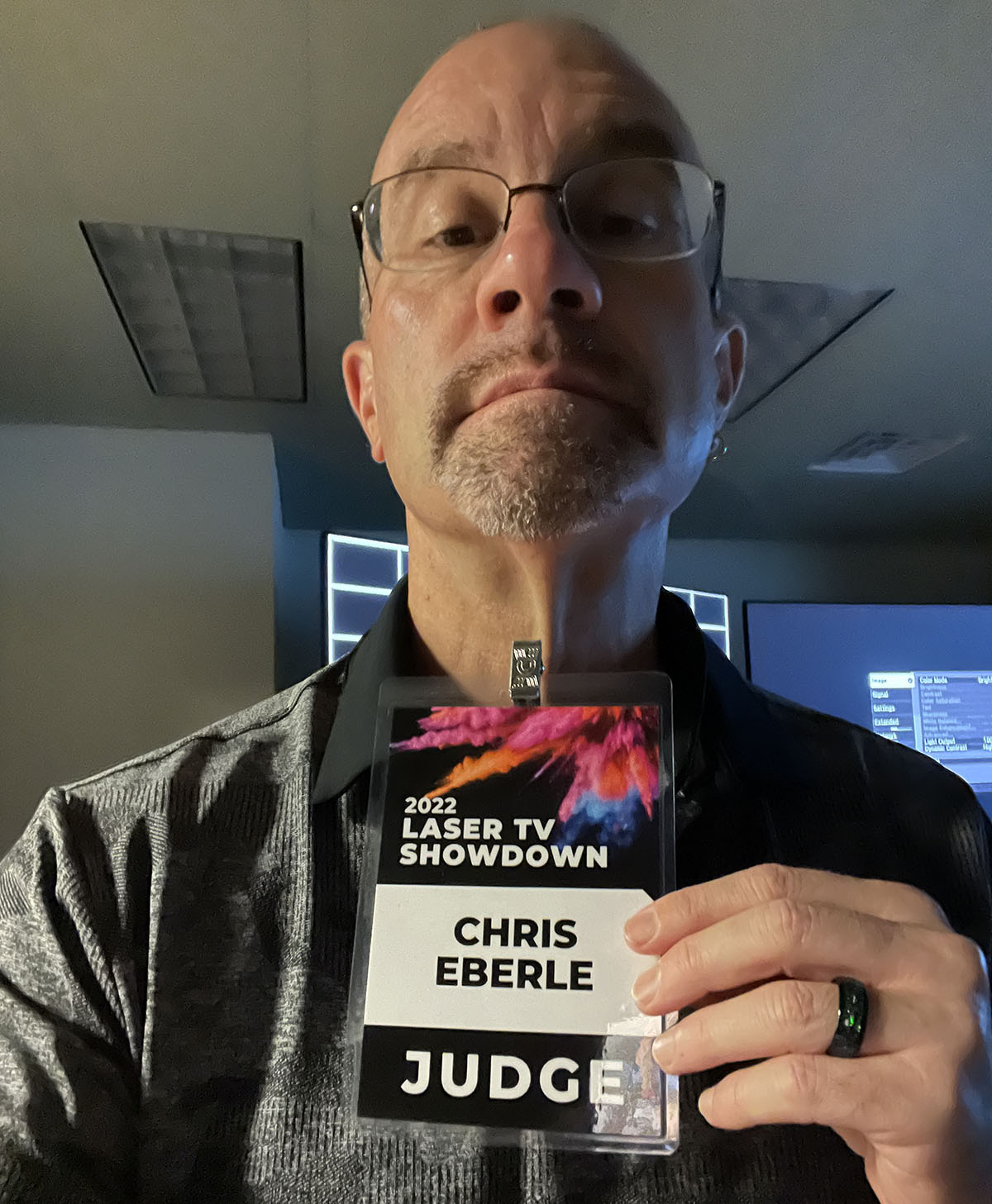 I even got a badge denoting my status as one of the six judges. No powdered wig or black robe though… I brought a gavel but decided to leave it at the hotel. In addition to myself, the judges came from a variety of online AV publications. There was Ralph Potts from AVS Forum, Sammy Prescott, Jr., ISF calibrator and reviewer for ProjectorCentral.com, Mark Henninger from Home Theater Review, Al Griffin from Tech Radar, and noted YouTube display reviewer, Chris Majestic. Most of us have been through some form of ISF training, and all are experienced video display testers and reviewers.
I even got a badge denoting my status as one of the six judges. No powdered wig or black robe though… I brought a gavel but decided to leave it at the hotel. In addition to myself, the judges came from a variety of online AV publications. There was Ralph Potts from AVS Forum, Sammy Prescott, Jr., ISF calibrator and reviewer for ProjectorCentral.com, Mark Henninger from Home Theater Review, Al Griffin from Tech Radar, and noted YouTube display reviewer, Chris Majestic. Most of us have been through some form of ISF training, and all are experienced video display testers and reviewers.
The projectors were split into single-laser and triple-laser categories. The eight displays in the single-laser category were BenQ’s V7050i (reviewed here at Secrets), Hisense 100L5G, ViewSonic X2000B, XGIMI Aura, Epson LS500, Samsung LSP7T, LG715Q, and Optoma’s Cinemax P2 (reviewed here at Secrets).
The triple-laser category is an emerging genre with newer models, some of which have just become available. We evaluated six units: the Formovie Theater, LG HU915QB, Hisense PX1-PRO, Samsung LSP9T, AWOL Vision LTV-3500, and Vava Chroma. The advantages to triple versus single laser are simple, extra brightness, and a wider color gamut. Also, the Formovie is one of a tiny handful of projectors that includes Dolby Vision support. The Hisense and AWOL projectors have that feature in beta testing.
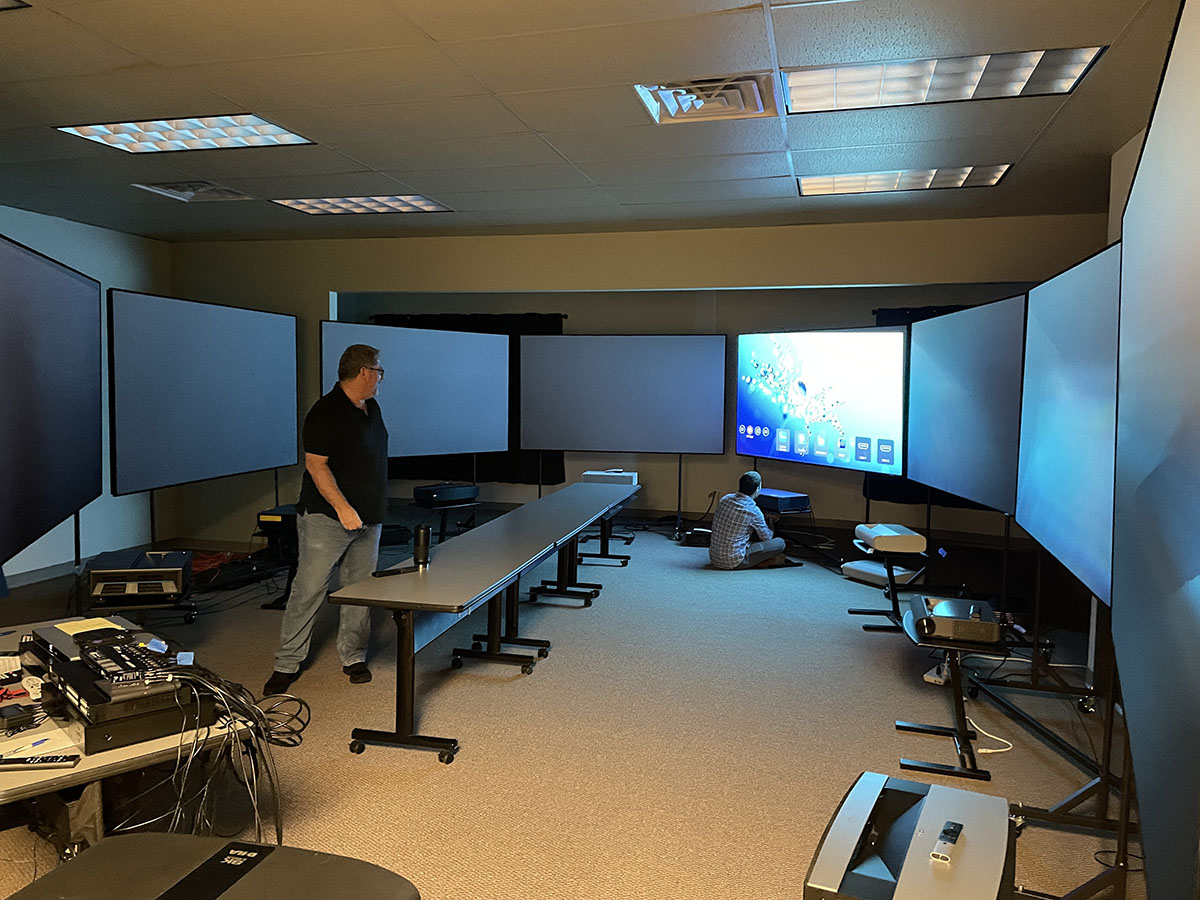 You can see by the above photo that we did not do a blind comparison. All of us knew which projector we were looking at. But the opportunity to see them side-by-side showing the same content on the same screen was something rare. The screens were identical copies of the 100-inch Vantage lenticular screen from Spectra Projection. A lenticular screen, for those who don’t know, is a special material designed specifically for UST projectors. It is made from microscopic prisms that accept light only from a low angle and beam it straight out towards the viewer. Light from the sides, front and above is rejected. Having seen these screens before, I can say that they are by far the best way to use a UST projector if you plan to actually replace a television. They deliver an excellent image in a room with some ambient light.
You can see by the above photo that we did not do a blind comparison. All of us knew which projector we were looking at. But the opportunity to see them side-by-side showing the same content on the same screen was something rare. The screens were identical copies of the 100-inch Vantage lenticular screen from Spectra Projection. A lenticular screen, for those who don’t know, is a special material designed specifically for UST projectors. It is made from microscopic prisms that accept light only from a low angle and beam it straight out towards the viewer. Light from the sides, front and above is rejected. Having seen these screens before, I can say that they are by far the best way to use a UST projector if you plan to actually replace a television. They deliver an excellent image in a room with some ambient light.
With the projectors all calibrated to SMPTE standards by Dave Harper, ISF calibrator for ProjectorScreen.com, we set about judging them in three scenarios: out-of-box bright room mode with the lights turned on, SDR calibrated dark room and HDR calibrated dark room. For the first scenario, we viewed a variety of TV content like CNN, sports, and shows. For the dark room modes, we used movies mainly, along with reference footage from Planet Earth and other 4K and HDR-based documentaries.
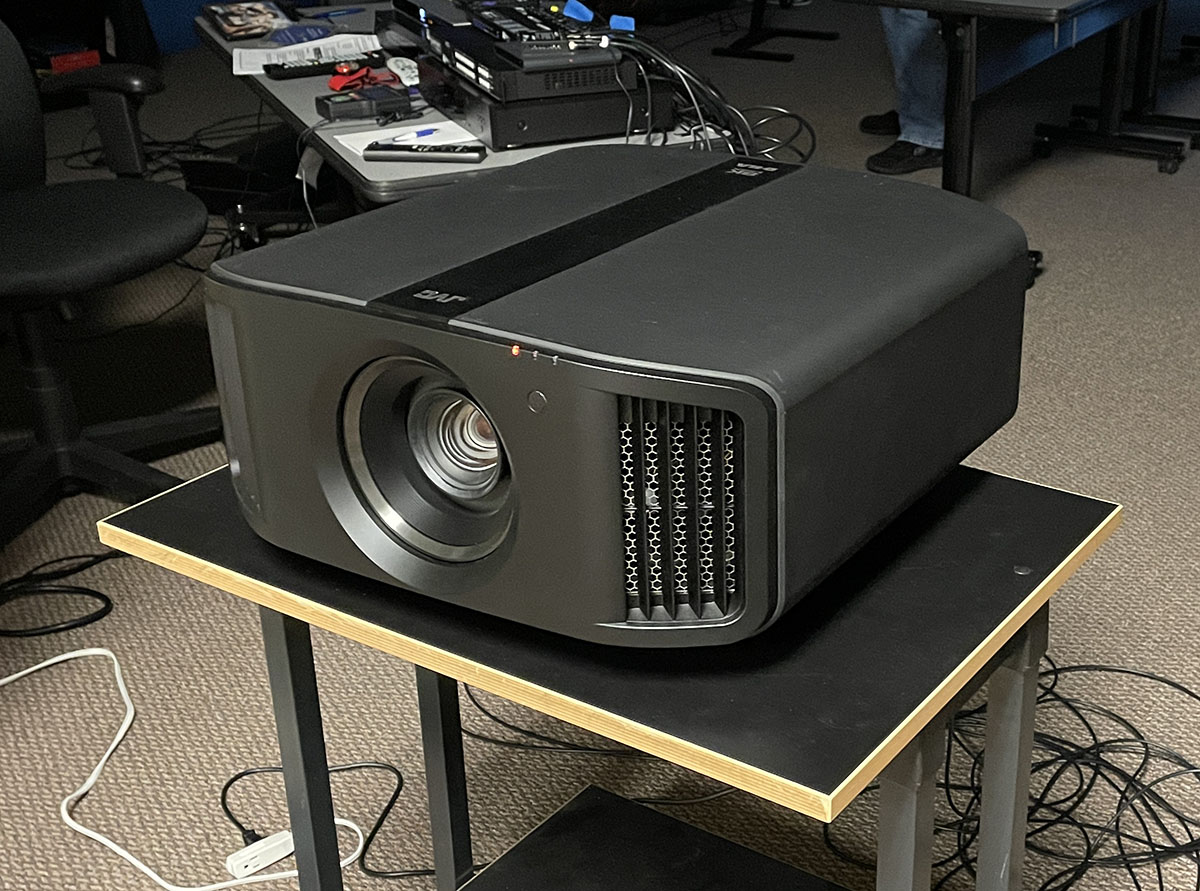 As a reference, a JVC DLA-NZ8 LCoS projector was installed in a neighboring room with a Stewart Filmscreen Studiotek 130 screen. Though some light bled into its space, it was mostly in the dark and we could look at the reference image at any time during the comparison. It was stunning, to say the least, but that’s to be expected from a $16,000 projector.
As a reference, a JVC DLA-NZ8 LCoS projector was installed in a neighboring room with a Stewart Filmscreen Studiotek 130 screen. Though some light bled into its space, it was mostly in the dark and we could look at the reference image at any time during the comparison. It was stunning, to say the least, but that’s to be expected from a $16,000 projector.
The content was fed from a variety of sources: DirecTV Satellite Receiver, Oppo UDP-203 Disc Player, and a Kaleidescape server. We could also view patterns from a Murideo signal generator. Using a very sophisticated matrix system and a whole lotta’ HDMI cables, we could see the clips on every projector simultaneously. Though there were some hiccups as signal formats changed, it was easy for me and the other judges to make meaningful comparisons.
Our score sheets listed the projectors across the top and the criteria down the sides. For each scenario, we rated color accuracy, detail/sharpness, contrast/tone-mapping, and black level/shadow detail. We also viewed some 4,000-nit material in the HDR scenario to evaluate how each projector handled those difficult highlights. Needless to say, the JVC aced everything…
 The results have been weighted towards the all-important contrast and color accuracy criteria with less emphasis placed on things like 4,000-nit tone-mapping and 24p motion. Also, less weight was given to the SDR Day Mode scenario so more emphasis could be placed on dark room or theater environments.
The results have been weighted towards the all-important contrast and color accuracy criteria with less emphasis placed on things like 4,000-nit tone-mapping and 24p motion. Also, less weight was given to the SDR Day Mode scenario so more emphasis could be placed on dark room or theater environments.
With a consistently strong showing in every metric, the BenQ V7050i won the single-laser category. All the judges agreed that it had the best image in all three scenarios. It was also the only projector of the entire showdown that didn’t need its settings checked every time we changed signal formats. Most of the other displays had trouble always keeping their calibrated settings in play. The BenQ’s only flaw was that it was the slowest to change formats. Part of this was the matrix system in use. When I reviewed the V7050i last year, I didn’t note any overt sluggishness. In fairness though, my reference is an old JVC/Anthem projector which is notoriously slow to lock onto a signal.
You can also see that no projector was significantly better or worse than any other. They are all pretty close in performance. And some did better with some content than others. While the BenQ would be my pick for its versatility and consistency, I would not turn any of these displays away. They all deliver a good picture.
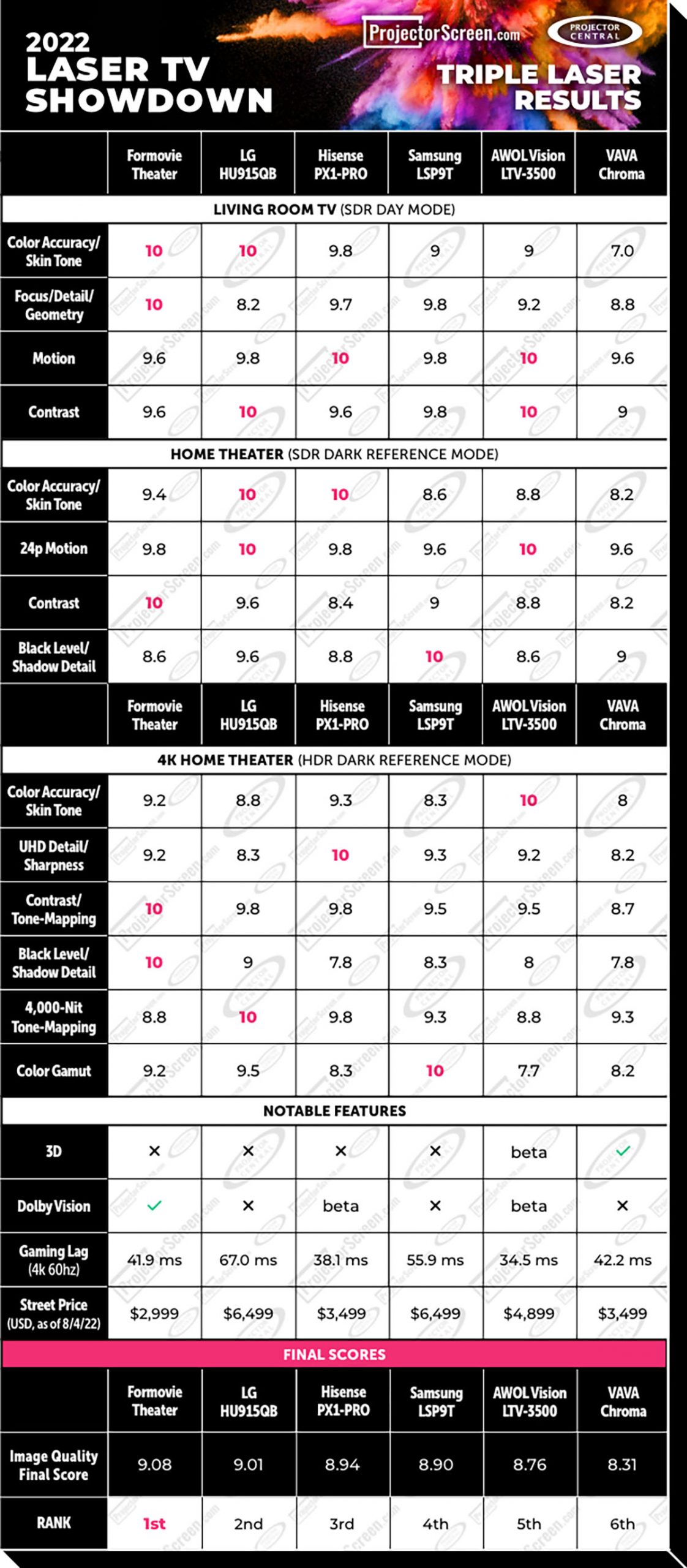 Triple-laser UST projectors are a relatively new category, and I have not had the opportunity to review one yet. I had not heard of Formovie or AWOL before. According to some of the other judges, the Formovie is the darling of the AVS forum at present, and obviously, it has enough going for it to earn the win here. An interesting thing to note is that for the triple-laser contest, we left the ViewSonic X2000B running as a secondary reference. It finished third in the ultimate scoring, but it was well regarded by all the judges.
Triple-laser UST projectors are a relatively new category, and I have not had the opportunity to review one yet. I had not heard of Formovie or AWOL before. According to some of the other judges, the Formovie is the darling of the AVS forum at present, and obviously, it has enough going for it to earn the win here. An interesting thing to note is that for the triple-laser contest, we left the ViewSonic X2000B running as a secondary reference. It finished third in the ultimate scoring, but it was well regarded by all the judges.
In my opinion, none of the triple-laser displays looked significantly better than the ViewSonic. The main advantage to this technology is its extra light output and wider color gamut. These things will certainly help if you plan to use the projector in a media room with some ambient light. But in dark room settings, I see little reason to spend the extra money at present. Yes, there is a little more color saturation. But the gamuts of these projectors are not uniformly larger. Some add red, others add green or blue. None of them were consistent when showing DCI-P3 or Rec.2020 mastered content. Honestly, I preferred the single-laser models because their gamuts were more accurate overall.
The 2022 Laser TV Showdown was a fascinating, fun, and educational experience for me. Though the TV shootout is nothing new, this is the first time, to my knowledge, that 14 UST projectors have been lined up in the same place, at the same time, showing the same content. Making side-by-side comparisons is like gold in this business. We always get products to review one at a time and making meaningful comparisons between displays is difficult. I like to stick to the numbers and for the most part, that is a great way to decide on a purchase. But when you can calibrate a group of projectors to the same standard and show them in a single environment, a few more things come to light (pun intended).
As a category, UST projectors can replace a television given the right room. With a lenticular screen, which I consider a must if you plan to leave the lights on, the image is as good as a decent LCD panel. No, you will not be able to compete with a bright sunny window. Only the most searingly bright TV can accomplish that. But with moderate overhead or lamp lights, the image is bold, saturated, and well-detailed. And it’s bright enough to satisfy. The big thing here is of course… big, as in the screen. A UST projector starts at 100 inches, and some can easily fill a 120- or 150-inch screen. Sure, you can buy an 83-inch OLED or an 85-inch LCD, but nothing can truly replace the jumbo screen experience. Many thanks to Rob Sabin of ProjectorCentral.com, Brian Gluck of ProjectorScreen.com, and all the sponsors of the 2022 Laser TV Showdown for a well-run and enjoyable event.
Many thanks to Rob Sabin of ProjectorCentral.com, Brian Gluck of ProjectorScreen.com, and all the sponsors of the 2022 Laser TV Showdown for a well-run and enjoyable event.


